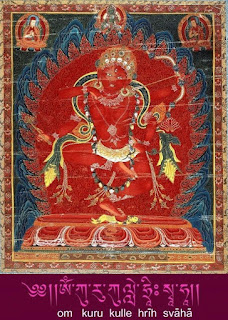Kurukulle or Kurukulla, also known as Rigjedma is the Tibetan Buddhist Goddess of Love, Lust, Sex, Magick, Enchantment and Liberation-Bobby Octo
Kurukulla is a goddess whose body is usually depicted in red with four arms, holding a bow and arrows made of flowers. She dances in a Dakini-pose and crushes the asura Rahu (the one who devours the sun). According to Vedic astrology, Rahu is a snake with a demon head (Navagraha) who represents the ascending lunar node.
She is considered either an incarnation of Amida Buddha, one of Tara's forms, or a transformation of Heruka. -Wikipedia
堪布貝瑪千貝仁波切─
咕嚕咕咧佛母又名作明佛母,是密教的愛神,也是司掌權威的祕密本尊,面孔含笑帶怒,含笑是攝召眾生,具有圓滿情愛與增進人緣的大威神力。帶怒是降伏諸魔,具足大權威勢。
om kuru kulle hrih svaha
嗡 咕汝 咕列 耶 梭哈
1 . 真實語妙音成就
2. 空樂俱生智成就
3. 自在攝三界成就
4. 成辦四事業成就
5. 得生天界成就
6. 破黑暗蔽障成明性
7. 斷一切妄想分別執著
8. 迅速圓滿福慧二資糧
9. 增上無漏大樂智慧
10.並可勾召含識之心
11.上蒙垂愛下得崇敬
12.得一切諸佛菩薩聲聞緣覺聖眾之加持
13.得一切帝釋梵天自在天之威權,福德,財富之加持
14.一切世間及出世間智
15.不死之身長壽成就
願以此功德,普及於一切。
我等與眾生,皆共成佛道。

No comments:
Post a Comment